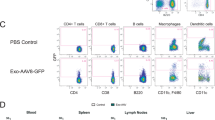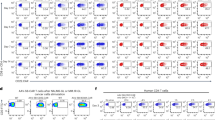Abstract
Genetically engineered lymphocytes hold promise for the treatment of genetic disease, viral infections and cancer. However, current methods for genetic transduction of peripheral blood lymphocytes rely on viral vectors, which are hindered by production and safety-related problems. In this study, we demonstrated an efficient novel nonviral platform for gene transfer to lymphocytes. The Sleeping Beauty transposon-mediated approach allowed for long-term stable expression of transgenes at ∼50% efficiency. Utilizing transposon constructs expressing tumor antigen-specific T-cell receptor genes targeting p53 and MART-1, we demonstrated sustained expression and functional reactivity of transposon-engineered lymphocytes on encountering target antigen presented on tumor cells. We found that transposon- and retroviral-modified lymphocytes had comparable transgene expression and phenotypic function. These results demonstrate the promise of nonviral ex vivo genetic modification of autologous lymphocytes for the treatment of cancer and immunologic disease.
This is a preview of subscription content, access via your institution
Access options
Subscribe to this journal
Receive 12 print issues and online access
$259.00 per year
only $21.58 per issue
Buy this article
- Purchase on Springer Link
- Instant access to full article PDF
Prices may be subject to local taxes which are calculated during checkout




Similar content being viewed by others
References
Rosenberg SA, Restifo NP, Yang JC, Morgan RA, Dudley ME . Adoptive cell transfer: a clinical path to effective cancer immunotherapy. Nat Rev 2008; 8: 299–308.
Dudley ME, Rosenberg SA . Adoptive cell transfer therapy. Semin Oncol 2007; 34: 524–531.
Dudley ME, Wunderlich JR, Yang JC, Sherry RM, Topalian SL, Restifo NP et al. Adoptive cell transfer therapy following non-myeloablative but lymphodepleting chemotherapy for the treatment of patients with refractory metastatic melanoma. J Clin Oncol 2005; 23: 2346–2357.
Kershaw MH, Teng MW, Smyth MJ, Darcy PK . Supernatural T cells: genetic modification of T cells for cancer therapy. Nat Rev Immunol 2005; 5: 928–940.
Cohen CJ, Zheng Z, Bray R, Zhao Y, Sherman LA, Rosenberg SA et al. Recognition of fresh human tumor by human peripheral blood lymphocytes transduced with a bicistronic retroviral vector encoding a murine anti-p53 TCR. [erratum appears in J Immunol. 2006 Oct 15; 177(8):5746] J Immunol 2005; 175: 5799–5808.
Hughes MS, Yu YY, Dudley ME, Zheng Z, Robbins PF, Li Y et al. Transfer of a TCR gene derived from a patient with a marked antitumor response conveys highly active T-cell effector functions. Hum Gene Ther 2005; 16: 457–472.
Morgan RA, Dudley ME, Yu YY, Zheng Z, Robbins PF, Theoret MR et al. High efficiency TCR gene transfer into primary human lymphocytes affords avid recognition of melanoma tumor antigen glycoprotein 100 and does not alter the recognition of autologous melanoma antigens. J Immunol 2003; 171: 3287–3295.
Zhao Y, Zheng Z, Robbins PF, Khong HT, Rosenberg SA, Morgan RA . Primary human lymphocytes transduced with NY-ESO-1 antigen-specific TCR genes recognize and kill diverse human tumor cell lines. J Immunol 2005; 174: 4415–4423.
Morgan RA, Dudley ME, Wunderlich JR, Hughes MS, Yang JC, Sherry RM et al. Cancer regression in patients after transfer of genetically engineered lymphocytes.[see comment]. Science 2006; 314: 126–129.
Gattinoni L, Klebanoff CA, Palmer DC, Wrzesinski C, Kerstann K, Yu Z et al. Acquisition of full effector function in vitro paradoxically impairs the in vivo antitumor efficacy of adoptively transferred CD8+ T cells.[see comment]. J Clin Invest 2005; 115: 1616–1626.
Pannell D, Ellis J . Silencing of gene expression: implications for design of retrovirus vectors. Rev Med Virol 2001; 11: 205–217.
Swindle CS, Klug CA . Mechanisms that regulate silencing of gene expression from retroviral vectors. J Hematother Stem Cell Res 2002; 11: 449–456.
Hacein-Bey-Abina S, von Kalle C, Schmidt M, Le Deist F, Wulffraat N, McIntyre E et al. A serious adverse event after successful gene therapy for X-linked severe combined immunodeficiency.[see comment]. N Engl J Med 2003; 348: 255–256.
Wu X, Li Y, Crise B, Burgess SM . Transcription start regions in the human genome are favored targets for MLV integration [see comment]. Science 2003; 300: 1749–1751.
Hackett PB, Ekker SC, Largaespada DA, McIvor RS . Sleeping beauty transposon-mediated gene therapy for prolonged expression. Adv Genet 2005; 54: 189–232.
Ivics Z, Izsvak Z . Transposons for gene therapy! Curr Gene Ther 2006; 6: 593–607.
Liu L, Mah C, Fletcher BS . Sustained FVIII expression and phenotypic correction of hemophilia A in neonatal mice using an endothelial-targeted sleeping beauty transposon. Mol Ther 2006; 13: 1006–1015.
Ortiz-Urda S, Lin Q, Yant SR, Keene D, Kay MA, Khavari PA . Sustainable correction of junctional epidermolysis bullosa via transposon-mediated nonviral gene transfer. Gene Therapy 2003; 10: 1099–1104.
Yant SR, Meuse L, Chiu W, Ivics Z, Izsvak Z, Kay MA . Somatic integration and long-term transgene expression in normal and haemophilic mice using a DNA transposon system. Nat Genet 2000; 25: 35–41.
Huang X, Wilber AC, Bao L, Tuong D, Tolar J, Orchard PJ et al. Stable gene transfer and expression in human primary T cells by the Sleeping Beauty transposon system. Blood 2006; 107: 483–491.
Yant SR, Park J, Huang Y, Mikkelsen JG, Kay MA . Mutational analysis of the N-terminal DNA-binding domain of sleeping beauty transposase: critical residues for DNA binding and hyperactivity in mammalian cells. Mol Cell Biol 2004; 24: 9239–9247.
Zayed H, Izsvak Z, Walisko O, Ivics Z . Development of hyperactive sleeping beauty transposon vectors by mutational analysis. Mol Ther 2004; 9: 292–304.
Wilber A, Frandsen JL, Geurts JL, Largaespada DA, Hackett PB, McIvor RS . RNA as a source of transposase for Sleeping Beauty-mediated gene insertion and expression in somatic cells and tissues. Mol Ther 2006; 13: 625–630.
Liu G, Geurts AM, Yae K, Srinivasan AR, Fahrenkrug SC, Largaespada DA et al. Target-site preferences of Sleeping Beauty transposons. J Mol Biol 2005; 346: 161–173.
Yant SR, Wu X, Huang Y, Garrison B, Burgess SM, Kay MA . High-resolution genome-wide mapping of transposon integration in mammals. Mol Cell Biol 2005; 25: 2085–2094.
Geurts AM, Yang Y, Clark KJ, Liu G, Cui Z, Dupuy AJ et al. Gene transfer into genomes of human cells by the sleeping beauty transposon system. Mol Ther 2003; 8: 108–117.
Cavalieri S, Cazzaniga S, Geuna M, Magnani Z, Bordignon C, Naldini L et al. Human T lymphocytes transduced by lentiviral vectors in the absence of TCR activation maintain an intact immune competence. Blood 2003; 102: 497–505.
Zhou X, Cui Y, Huang X, Yu Z, Thomas AM, Ye Z et al. Lentivirus-mediated gene transfer and expression in established human tumor antigen-specific cytotoxic T cells and primary unstimulated T cells. Hum Gene Ther 2003; 14: 1089–1105.
Kuball J, Schmitz FW, Voss RH, Ferreira EA, Engel R, Guillaume P et al. Cooperation of human tumor-reactive CD4+ and CD8+ T cells after redirection of their specificity by a high-affinity p53A2.1-specific TCR. Immunity 2005; 22: 117–129.
Huang X, Guo H, Kang J, Choi S, Zhou TC, Tammana S et al. Sleeping Beauty transposon-mediated engineering of human primary T cells for therapy of CD19+ lymphoid malignancies. Mol Ther 2008; 16: 580–589.
Singh H, Manuri PR, Olivares S, Dara N, Dawson MJ, Huls H et al. Redirecting specificity of T-cell populations for CD19 using the Sleeping Beauty system. Cancer Res 2008; 68: 2961–2971.
Kershaw MH, Westwood JA, Parker LL, Wang G, Eshhar Z, Mavroukakis SA et al. A phase I study on adoptive immunotherapy using gene-modified T cells for ovarian cancer. Clin Cancer Res 2006; 12: 6106–6115.
Lamers CH, Sleijfer S, Vulto AG, Kruit WH, Kliffen M, Debets R et al. Treatment of metastatic renal cell carcinoma with autologous T-lymphocytes genetically retargeted against carbonic anhydrase IX: first clinical experience. J Clin Oncol 2006; 24: e20–e22.
Park JR, Digiusto DL, Slovak M, Wright C, Naranjo A, Wagner J et al. Adoptive transfer of chimeric antigen receptor re-directed cytolytic T lymphocyte clones in patients with neuroblastoma. Mol Ther 2007; 15: 825–833.
Su Z, Dannull J, Heiser A, Yancey D, Pruitt S, Madden J et al. Immunological and clinical responses in metastatic renal cancer patients vaccinated with tumor RNA-transfected dendritic cells. Cancer Res 2003; 63: 2127–2133.
Till BG, Jensen MC, Wang J, Chen EY, Wood BL, Greisman HA et al. Adoptive immunotherapy for indolent non-Hodgkin lymphoma and mantle cell lymphoma using genetically modified autologous CD20-specific T cells. Blood 2008; 112: 2261–2271.
Ivics Z, Katzer A, Stuwe EE, Fiedler D, Knespel S, Izsvak Z . Targeted Sleeping Beauty transposition in human cells. Mol Ther 2007; 15: 1137–1144.
Yant SR, Huang Y, Akache B, Kay MA . Site-directed transposon integration in human cells. Nucleic Acids Res 2007; 35: e50.
Zhao Y, Zheng Z, Cohen CJ, Gattinoni L, Palmer DC, Restifo NP et al. High-efficiency transfection of primary human and mouse T lymphocytes using RNA electroporation. Mol Ther 2006; 13: 151–159.
Hughes MS, Yu YY, Dudley ME, Zheng Z, Robbins PF, Li Y et al. Transfer of a TCR gene derived from a patient with a marked antitumor response conveys highly active T-cell effector functions. Hum Gene Ther 2005; 16: 457–472.
Lizee G, Gonzales MI, Topalian SL . Lentivirus vector-mediated expression of tumor-associated epitopes by human antigen presenting cells. Hum Gene Ther 2004; 15: 393–404.
Riddell SR, Greenberg PD . The use of anti-CD3 and anti-CD28 monoclonal antibodies to clone and expand human antigen-specific T cells. J Immunol Methods 1990; 128: 189–201.
Cohen CJ, Zheng Z, Bray R, Zhao Y, Sherman LA, Rosenberg SA et al. Recognition of fresh human tumor by human peripheral blood lymphocytes transduced with a bicistronic retroviral vector encoding a murine anti-p53 TCR. J Immunol 2005; 175: 5799–5808.
Szymczak AL, Workman CJ, Wang Y, Vignali KM, Dilioglou S, Vanin EF et al. Correction of multi-gene deficiency in vivo using a single ‘self-cleaving’ 2A peptide-based retroviral vector. Nat Biotechnol 2004; 22: 589–594.
Johnson LA, Heemskerk B, Powell Jr DJ, Cohen CJ, Morgan RA, Dudley ME et al. Gene transfer of tumor-reactive TCR confers both high avidity and tumor reactivity to nonreactive peripheral blood mononuclear cells and tumor-infiltrating lymphocytes. J Immunol 2006; 177: 6548–6559.
Cohen CJ, Zhao Y, Zheng Z, Rosenberg SA, Morgan RA . Enhanced antitumor activity of murine-human hybrid T-Cell receptor (TCR) in human lymphocytes is associated with improved pairing and TCR/CD3 stability. Cancer Res 2006; 66: 8878–8886.
Morgan RA, Dudley ME, Yu YY, Zheng Z, Robbins PF, Theoret MR et al. High efficiency TCR gene transfer into primary human lymphocytes affords avid recognition of melanoma tumor antigen glycoprotein 100 and does not alter the recognition of autologous melanoma antigens. J Immunol 2003; 171: 3287–3295.
Acknowledgements
We thank Dr Steven R Yant and Dr Mark A Kay of the Departments of Pediatrics and Genetics, Stanford University School of Medicine, Stanford, CA, for their generous gift of the Sleeping Beauty transposon plasmids and hyperactive transposase, as well as for their helpful suggestions on this project. We thank FACS lab and TIL lab in Surgery Branch for providing technical support and maintenance of tumor cells from patients. This work is supported by the Intramural Research Program of the National Institute of Health, National Cancer Institute, Center for Cancer Research.
Author information
Authors and Affiliations
Corresponding author
Rights and permissions
About this article
Cite this article
Peng, P., Cohen, C., Yang, S. et al. Efficient nonviral Sleeping Beauty transposon-based TCR gene transfer to peripheral blood lymphocytes confers antigen-specific antitumor reactivity. Gene Ther 16, 1042–1049 (2009). https://doi.org/10.1038/gt.2009.54
Received:
Revised:
Accepted:
Published:
Issue Date:
DOI: https://doi.org/10.1038/gt.2009.54
Keywords
This article is cited by
-
A highly soluble Sleeping Beauty transposase improves control of gene insertion
Nature Biotechnology (2019)
-
Gene editing for immune cell therapies
Nature Biotechnology (2019)
-
Adoptive cellular therapies: the current landscape
Virchows Archiv (2019)
-
Principles of adoptive T cell therapy in cancer
Seminars in Immunopathology (2019)
-
Enhanced CAR T-cell engineering using non-viral Sleeping Beauty transposition from minicircle vectors
Leukemia (2017)



